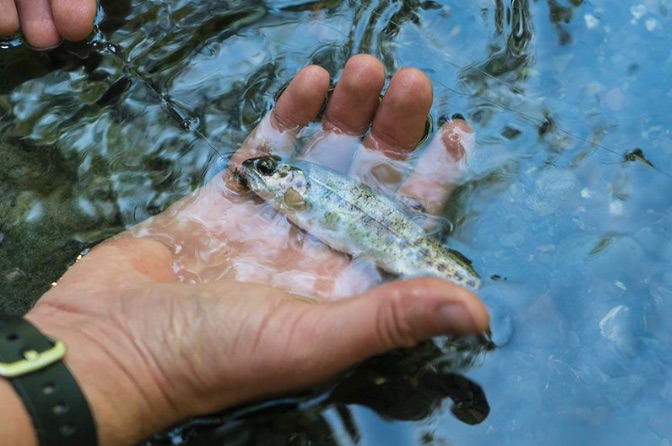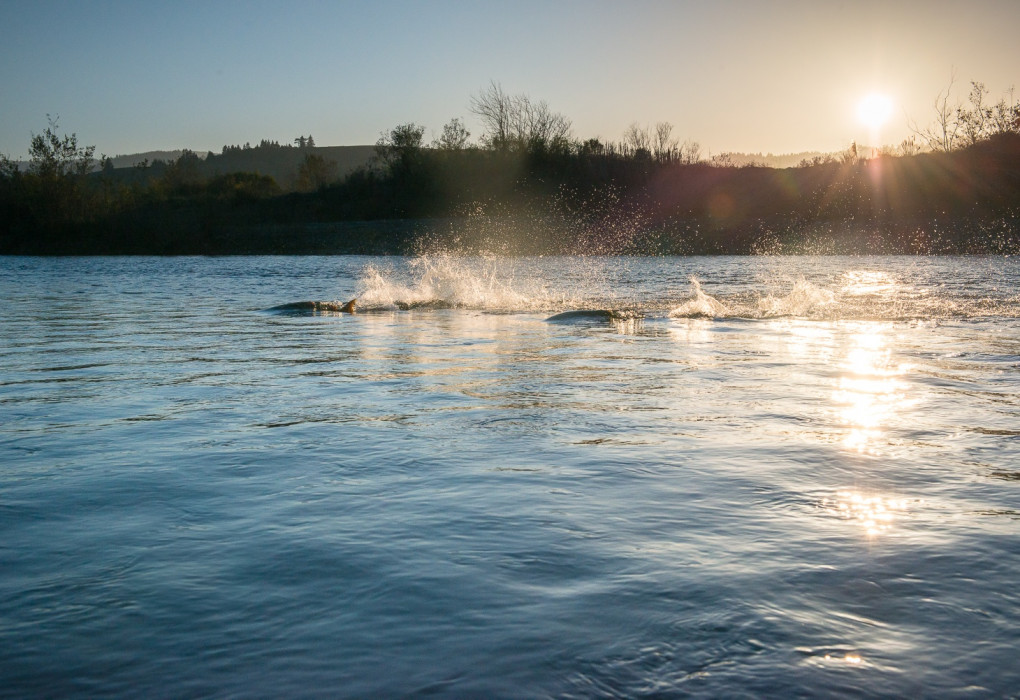Looking ahead for the Eel River and the Potter Valley Project
A great deal has happened over the last four years since we started our temperature monitoring work throughout the headwaters of California’s Eel River to prepare for the relicensing of the Potter Valley Project in 2022. As we start 2019, I thought it would be important to give a quick recap of some of the most noteworthy developments with a look ahead for what to (potentially) expect in the coming year.
First, this will be our fifth year studying whether the hundreds of miles of upper Eel River tributaries above Scott Dam currently inaccessible to salmon and steelhead contain suitable temperatures to support these iconic cold-water species during the warm summer months. Our first two years of monitoring, available in a preliminary report here, identified that “yes”, during June - October (in 2015 & 2016) there was significant potential for the upper Eel River tributaries to provide important cold water sources offering both suitable and even optimal temperatures for the life history requirements of salmonids. Access to this headwater habitat will be critical for salmonids to remain resilient in a changing climate, and our goal in dam relicensing is to ensure this population of all wild salmon and steelhead are able to volitionally access this important cold-water refuge, with dam removal being the preferred option. We’ll place our final year of temperature probes this summer and keep your eyes out for a report compiling all five years of data due for release next winter.
Second, in a surprising turn of events, Pacific Gas & Electric (PG&E), owners of the Potter Valley Project, after filing notice to the Federal Energy Regulatory Commission (FERC - the federal agency in charge of permitting hydropower projects) to start the relicensing process for the project announced their plans to auction it off -- essentially putting the project up for sale. This is a huge development in the future of the Eel River and has left conservation and commercial fishing groups, Tribal nations, agricultural interests, and local municipalities and water agencies across the region unsure about what the future of the Eel will look like.
The 110 year-old Potter Valley Project provides minimal hydroelectricity generation, rarely meeting its maximum load capacity of just over 9 megawatts of power; however, it provides an important water supply to the neighboring Russian River through a diversion and tunnel system that sends water through the agriculturally-focus Potter Valley to the nearby Russian River. It was an engineering marvel in the early 1900s, but it also cut off access to nearly 300 miles of quality habitat in the uppermost basin for wild salmon and steelhead through the construction of Scott Dam. Built without fish passage, Scott Dam blocks access for wild salmon and steelhead and restricts the transport of gravel and large woody debris for downstream spawning and rearing habitat.
Ultimately, the Potter Valley Project provides negligent benefit to PG&E’s overall power-generation portfolio (less than .01%) and its costs are increasingly outweighing its benefits given changing power structures and new environmental regulations that require fish passage for relicensing dams, as well as the opportunity to look at other considerations afforded during the relicensing process.
Third, speaking of liability, more information is coming out about problems inherent with the Potter Valley Project and particularly Scott Dam. For example, a recent Friends of the Eel River analysis of Scott Dam revealed the nearby Bartlett Springs Fault Complex, which paired with a landslide just above the dam presents “a significant geologic hazard” - in an area that is earthquake prone. You may recall the recent Oroville disaster where dam safety concerns were sidelined for years until the hillside supporting the structure eroded so fast during a large rain event it caused extensive damage to the spillway, forcing the evacuation of nearby communities. For liability considerations, Scott Dam joins a list of over 100 dams in California alone that are at serious risk for life and property damage from being built on fault lines and potential earthquakes that could cause extensive damage to the dam, rivers and local communities. FOER has repeatedly asked FERC to consider dam safety, but the federal agency has refused to incorporate these into relicensing decisions. (Be sure to read FOER, Scott Greacen’s article in Water Deeply “Will a Landslide on the Eel River Cause California’s Next Dam Disaster?”)
Lastly, in addition to the dam liabilities, two years of tragic fires are allegedly caused by PG&E power line failures that could have serious implications for the utility company’s future in terms of legal liability and their ability to weather financial responsibilities, which some suspect could ultimately lead to bankruptcy (see more on the fire liabilities here (2017) and here (2018)). For instance, PG&E stock market shares have taken major hits following statement’s by the California Department of Forestry and Fire Protection (CalFire) alleging liability over 2017 and 2018 fires, including the recent Camp Fire, which tragically destroyed the town of Paradise, CA.
What does this mean for the Eel River and wild salmon and steelhead? In short, it means that PG&E is looking to lessen its liabilities across the state, and the low power-generating, high-cost Potter Valley Project will be at the top of the list of assets to dump. It also means that the future is uncertain for dam ownership and whether wild salmon and steelhead will get what they need at this important juncture.
Looking ahead for the Eel River and Potter Valley Project
If you're interested in purchasing the Potter Valley Project (like me), you’ll join a list of a nearly twenty entities looking to get their hands on the dam complex; although non-disclosure requirements prevent us from fully knowing who has put their bid in. The bidding process has started and eligible candidates will have to meet PG&E’s and FERC requirements, and the expectation is that you will purchase the project to take on its liabilities and continue meeting power-generation and water transfer agreements. Purchasing the project for the sole purpose of decommissioning isn’t part of the cards, at this point.
Native Fish Society, along with our conservation and fishing partners continue to be engaged in the FERC relicensing process, which will remain a requirement for any entity that decides to purchase the Potter Valley Project. It is highly unlikely that any new entity will be able to side-skirt the FERC relicensing process and we’re working to ensure that volitional fish passage is the only option for returning wild salmon and steelhead to the currently inaccessible, previously occupied headwater habitat. An auxiliary process is underway from Congressman Jared Huffman (D - District 2) that is bringing together an Ad Hoc group of stakeholders to seek a two-basin solution to the Potter Valley Project, and a lot of good information about fish passage and water storage options is coming out of this process to help inform relicensing discussions. These meetings will continue throughout the year and we will keep you all apprised of the status and opportunities to share your voice for a wild and free Eel River.
Finally, we are excited to report that thanks to the support of the Patagonia World Trout Initiative we were able to secure important funding to help get a better scientific understanding of the genetic makeup of resident o. mykiss (rainbow trout) above Scott Dam. In partnership with University of California - Davis, Samantha Kannry (NFS Redwood Coast District Coordinator and UC Davis graduate student) will apply new research findings in animal genomics to help understand o. mykiss that are present in the habitat inaccessible to wild steelhead for over a century.
Currently, resident o. mykiss (rainbow trout) are found above Scott Dam, although their origin is unknown. Understanding the origin of these fish will play a significant role in the project relicensing, and will provide important insight into setting goals for steelhead reintroduction into the upper watershed currently blocked by Scott Dam.

More specifically, these resident o. mykiss could be the offspring of historic hatchery trout plantings in Lake Pillsbury (the reservoir formed by Scott Dam) or they could be the offspring of Eel River wild steelhead from nearly a century ago. If the o.mykiss are found to be of native-origin, the likelihood and opportunity for a successful restoration of wild steelhead in the upper Eel River is greatly improved, versus attempts at restoration using hatchery fish, as has been the case in many other watersheds where dam removal has occurred. Additionally, new genomic research will allow us to determine whether these resident o.mykiss are descendants of winter or summer run steelhead. This second question is of tremendous value as well.
If the tissue samples and genetic analysis reveal that the o.mykiss above Scott Dam are 1) legacy, wild o. mykiss and potentially 2) the descendants of summer steelhead(!), dam removal will not only benefit currently threatened chinook and winter steelhead, but also create the opportunity to resurrect the southernmost run of wild summer steelhead in North America. For native fish recovery in the Northwest, it’s hard to think of another opportunity of this magnitude anywhere else.
As development on the Eel continue to develop, we’ll be sure to keep you all appraised on one of the greatest opportunities to restore the largest all wild population of salmon and steelhead in California.
In the meantime, if you haven't seen the new award-winning film "A River's Last Chance" by North Fork Studios // Shane Anderson, which profiles the story of the Eel River highlighting the opportunity for recovery, be sure to give that a view -- it is available for rent or purchase online here.
